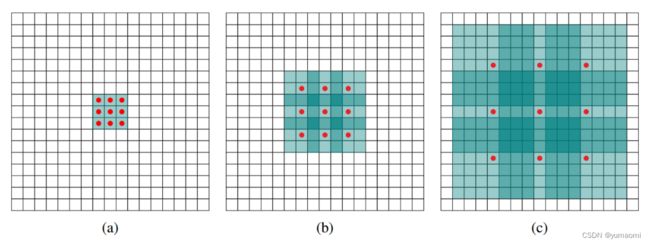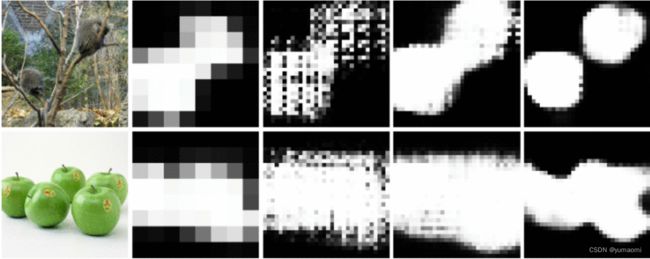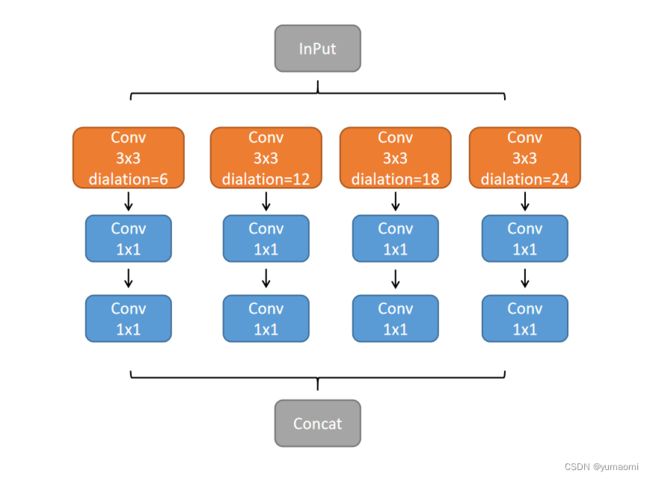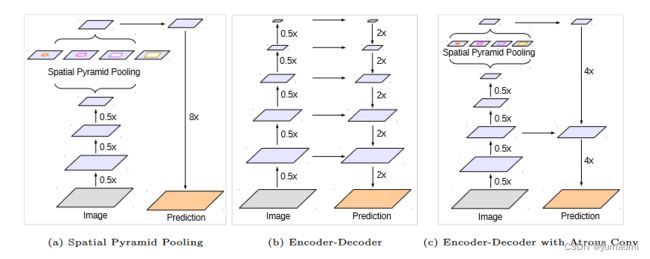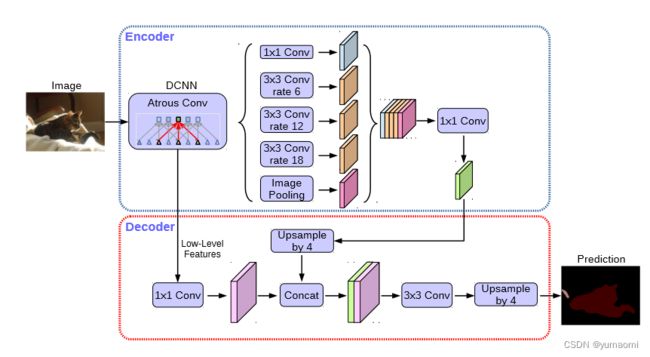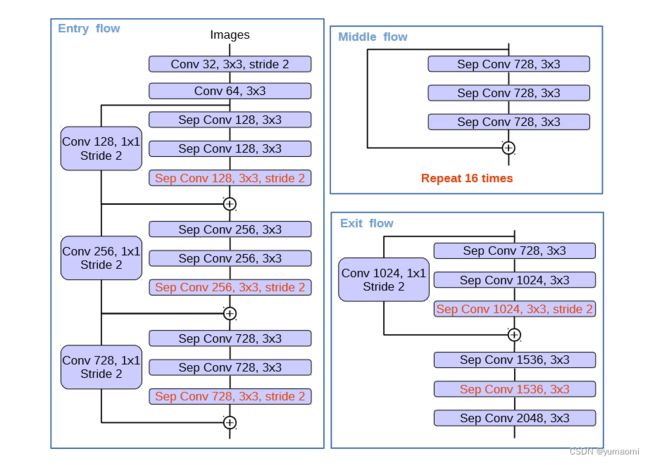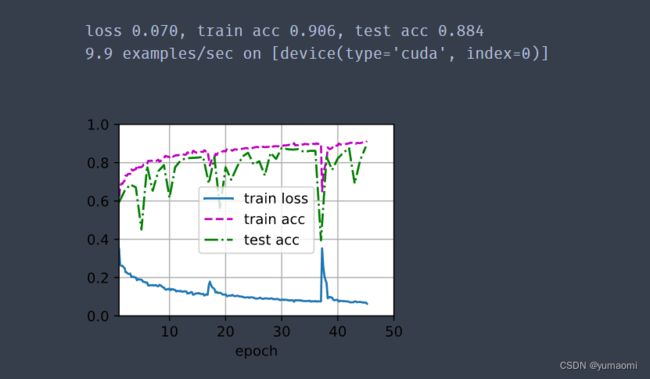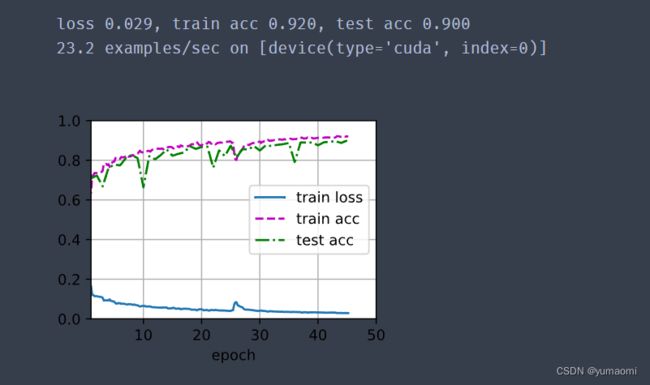语义分割系列-4 DeepLabV1-V3+(pytorch实现)
DeepLabV1-V3+系列很好的展示了一个模型是如何在发现问题->模型更新->解决问题这一流程中迭代进步的。每一次发现问题,再提出新的模块去解决,在模型中实现,获得好的效果。就这样,DeepLab从V1->V2->V3->V3+,DeepLab系列就像人工智能,在一步步进步,一点点解决问题。
因此,本文将从DeepLabV1开始,DeepLabV3+结束,讲述DeepLab家族的故事。并会在CamVid数据集上进行复现。所有代码都基于Pytorch。
DeepLab1
论文地址:DeepLab1:SEMANTIC IMAGE SEGMENTATION WITH DEEP CON- VOLUTIONAL NETS AND FULLY CONNECTED CRFS
概述:
原论文作者在发现DCNN(深度神经网络,Deep Convolutional Neural Networks)可以很容易解决分类问题却难以解决像素级别的分割问题后,进行了思考。作者认为,DCNN具有很好的平移不变性,所以在分类问题上效果很好,但是多次池化和下采样导致位置信息丢失,而空间的不变性导致了细节信息的丢失。所以,论文中提出了两个要解决的问题:
- 多次池化和下采样导致位置信息丢失。
- 空间的不变性导致细节信息的丢失。
既然提出了两个需要解决的问题,作者在这两个问题上分别提出了两个解决方案:
- 空洞卷积
- 全连接条件随机场(Fully-connected Conditional Random Field,CRF)
空洞卷积
可以说空洞卷积是DeepLab系列的灵魂之作,DCNN网络苦于感受野不深的问题已久。 2016年一篇论文中提出了有效感受野这一概念。原来的办法只能通过不停的堆叠卷积层或者增大卷积核,以求达到增加感受野的目的。但是呢,增大卷积核运算量会比较大,在当时是不可接受的(现在也有人开始研究超大卷积核的模型结构,比如2022的CVPR中RepLknet)。而空洞卷积的提出,则极大解决了感受野不够大的问题(至少在当时是这样的)。
图1中,a是普通的卷积能看到的感受野大小,卷积完成后每一个红点能看到前一层图像的3x3区域。b是dialation=2的空洞卷积,可以看到,同样是9个红色点参与运算,却可以看到7x7的区域。c是dialation=4的空洞卷积,9个点参与运算却可以看到15x15的区域。
空洞卷积和普通卷积的感受野就很显而易见了,而且最重要的是,空洞卷积不会增加额外的训练参数,在当时的硬件限制的情况下,相比于扩大卷积核或叠加卷积层,这种又节省参数又提升感受野的操作是很有市场的。
但是呢,空洞卷积自然也是有缺点的,就是网格问题(gridding问题)。但后续也有人会提出新的方法来解决这个问题。在此就不再赘述。总之,空洞卷积横空出世。
全连接条件随机场
作者在论文中提出使用全连接条件随机场(CRF)来解决分割中不平滑的问题和修复一些小的结构。
可以很明显的看到,随着CRF迭代次数增加,对飞机的分割效果越来越好。
模型结构
DeepLabV1的模型结构十分简单,基于VGG16做了一些改动。将VGG16的最后三层全连接层替换为卷积层。其中,第十一、十二、十三层为dilation=2的空洞卷积,第十四层为dilation=4的空洞卷积。
图中省去了CRF的结构,虽然不用CRF,但是DeepLabV1也能实现一个很好的效果。
DeepLabV2
DeepLabV1提出后不久,作者又发现了新问题--图像中存在多尺度的物体。
对于多尺度的物体,原来的模型效果堪忧。
DeepLabV2论文地址。
于是就提出了新的解决方法,就是大名鼎鼎的ASPP(Atrous Spatial Pyramid Pooling)
ASPP
ASPP就是在一层上并行多个不同dilation的空洞卷积,所有空洞卷积同步进行,用来获得不同尺度上的感受野,以提升不同尺度的物体分割效果。简单点说就是,让模型能同时看清楚大的物体和小的物体。
ASPP的实现也较为简单,本文给出了ASPP在pytorch框架上的实现。
#DeepLabv2使用的ASPPmodule
class ASPP_module(nn.ModuleList):
def __init__(self, in_channels, out_channels, dilation_list=[6, 12, 18, 24]):
super(ASPP_module, self).__init__()
self.dilation_list = dilation_list
for dia_rate in self.dilation_list:
self.append(
nn.Sequential(
nn.Conv2d(in_channels, out_channels, kernel_size=1 if dia_rate==1 else 3, dilation=dia_rate, padding=0 if dia_rate==1 else dia_rate),
nn.Conv2d(out_channels, out_channels, kernel_size=1),
nn.Conv2d(out_channels, out_channels, kernel_size=1),
)
)
def forward(self, x):
outputs = []
for aspp_module in self:
outputs.append(aspp_module(x))
return torch.cat(outputs, 1)DeepLabV3
当然,老问题解决了,新问题自然会出现。
因为ResNet的提出,作者开始思考,更深结构下,空洞卷积能实现什么样的效果?以及,ASPP结构是否能再度优化?
因此,在DeepLabV3的论文中,作者做了两部分的工作:
- 探索更深层的模型下,空洞卷积的效果。
- ASPP的优化。
论文的名字也取得很有含义,Rethinking Atrous Convolution for Semantic Image Segmentation
Rethinking!
DeepLab的故事告诉我们要多Thinking和Rethinking。
Going Deeper with Atrous Convolution
作者的第一个思路就是更深层的空洞卷积。ResNet的提出,让网络模型达到101(还能更深)。
作者做了一个对比试验,将ResNet深层的模块替换为空洞卷积,很显然,空洞卷积获得了比较大的感受野,而且可以捕获远端的信息,在最后一层中进行汇聚。当然,作者也提到,dilation rate的设计十分重要,不当的设计会造成精度降低。当然,作者也为我们做完实验并设计好了rate的组合。
Atrous Spatial Pyramid Pooling
作者再次提到了ASPP结构,并做了一定的优化。
因为作者在上述实验的情况中发现,dilation rate组合不当的情况下,3x3的卷积核会退化成1x1的卷积。因此,作者设计实验并重新调整了rate组合,从V2中的[6, 12, 18, 24] 改进成[1, 6, 12, 18]。
当然,作者觉得空洞卷积损失了一定信息,于是在ASPP上,并行了一个全局平均池化(图8 b),来保存全局的上下文信息。
至此,V3的改进就算完成了。
#DeepLabV3版本的ASPP
class ASPP_module(nn.ModuleList):
def __init__(self, in_channels, out_channels, dilation_list=[1, 6, 12, 18]):
super(ASPP_module, self).__init__()
self.dilation_list = dilation_list
for dia_rate in self.dilation_list:
self.append(
nn.Sequential(
nn.Conv2d(in_channels, out_channels, kernel_size=1 if dia_rate==1 else 3, dilation=dia_rate, padding=0 if dia_rate==1 else dia_rate),
nn.BatchNorm2d(out_channels),
nn.ReLU()
)
)
def forward(self, x):
outputs = []
for aspp_module in self:
outputs.append(aspp_module(x))
return torch.cat(outputs, 1)DeepLabV3+
当然了,你V3 Rethinking就Rethinking了一个深层结构和ASPP,级联结构怎么不加呢?
所以DeepLabV3+考虑了级联结构,来增加对上下文的理解。
论文地址:Encoder-Decoder with Atrous Separable Convolution for Semantic Image Segmentation
名字就叫,语义分割中Encoder-Decoder的ASPP应用。
模型结构
到这一步,就比较简单了。作者将ASPP加入到Encoder-decoder结构中。
再加上级联结构,作者就提出了DeepLabV3+模型。
当然,在作者写论文那个时期,在卷积模块上,Depthwise separable convolution(深度可分离卷积)又横空出世,作者开始思考能否将深度可分离卷积结合空洞卷积?实验证明是可行的,于是,作者提出了一个修改的Xception模型。说简单点,就是在深度可分离卷积上应用空洞卷积。
替换了一些卷积层为有不同dilation的深度可分离卷积。不过这和DeepLabV3+没什么关系。这里就不再赘述。
模型复现
DeepLabV1
VGG16作为backbone
import torch
import torch.nn as nn
class VGG13(nn.Module):
def __init__(self):
super(VGG13, self).__init__()
self.stage_1 = nn.Sequential(
nn.Conv2d(3, 64, kernel_size=3, stride=1, padding=1),
nn.BatchNorm2d(64),
nn.ReLU(),
nn.Conv2d(64, 64, kernel_size=3, stride=1, padding=1),
nn.BatchNorm2d(64),
nn.ReLU(),
nn.MaxPool2d(2,2),
)
self.stage_2 = nn.Sequential(
nn.Conv2d(64, 128, kernel_size=3, stride=1, padding=1),
nn.BatchNorm2d(128),
nn.ReLU(),
nn.Conv2d(128, 128, kernel_size=3, stride=1, padding=1),
nn.BatchNorm2d(128),
nn.ReLU(),
nn.MaxPool2d(2,2),
)
self.stage_3 = nn.Sequential(
nn.Conv2d(128, 256, kernel_size=3, stride=1, padding=1),
nn.BatchNorm2d(256),
nn.ReLU(),
nn.Conv2d(256, 256, kernel_size=3, stride=1, padding=1),
nn.BatchNorm2d(256),
nn.ReLU(),
nn.Conv2d(256, 256, kernel_size=3, stride=1, padding=1),
nn.BatchNorm2d(256),
nn.ReLU(),
nn.MaxPool2d(2,2),
)
self.stage_4 = nn.Sequential(
nn.Conv2d(256, 512, kernel_size=3, stride=1, padding=1),
nn.BatchNorm2d(512),
nn.ReLU(),
nn.Conv2d(512, 512, kernel_size=3, stride=1, padding=1),
nn.BatchNorm2d(512),
nn.ReLU(),
nn.Conv2d(512, 512, kernel_size=3, stride=1, padding=1),
nn.BatchNorm2d(512),
nn.ReLU(),
nn.MaxPool2d(2,stride=1, padding=1),
)
self.stage_5 = nn.Sequential(
#空洞卷积
nn.Conv2d(512, 512, kernel_size=3, stride=1, padding=2, dilation=2),
nn.BatchNorm2d(512),
nn.ReLU(),
nn.Conv2d(512, 512, kernel_size=3, stride=1, padding=2, dilation=2),
nn.BatchNorm2d(512),
nn.ReLU(),
nn.Conv2d(512, 512, kernel_size=3, stride=1, padding=2, dilation=2),
nn.BatchNorm2d(512),
nn.ReLU(),
nn.MaxPool2d(2, stride=1),
)
def forward(self, x):
x = x.float()
x1 = self.stage_1(x)
x2 = self.stage_2(x1)
x3 = self.stage_3(x2)
x4 = self.stage_4(x3)
x5 = self.stage_5(x4)
return [x1, x2, x3, x4, x5]class DeepLabV1(nn.Module):
def __init__(self, num_classes):
super(DeepLabV1, self).__init__()
#前13层是VGG16的前13层,分为5个stage
self.num_classes = num_classes
self.backbone = VGG13()
self.stage_1 = nn.Sequential(
#空洞卷积
nn.Conv2d(512, 512, kernel_size=3, stride=1, padding=4, dilation=4),
nn.BatchNorm2d(512),
nn.ReLU(),
nn.Conv2d(512, 512, kernel_size=1, stride=1, padding=0),
nn.BatchNorm2d(512),
nn.ReLU(),
nn.Conv2d(512, 512, kernel_size=1, stride=1, padding=0),
nn.BatchNorm2d(512),
nn.ReLU(),
)
self.final = nn.Sequential(
nn.Conv2d(512, self.num_classes, kernel_size=3, padding=1)
)
def forward(self, x):
#调用VGG16的前13层 VGG13
x = self.backbone(x)[-1]
x = self.stage_1(x)
x = nn.functional.interpolate(input=x,scale_factor=8,mode='bilinear')
x = self.final(x)
return xDeepLabV2
还是用VGG16作为backbone,同时写了ASPP模块。
import torch
import torch.nn as nn
class ASPP_module(nn.ModuleList):
def __init__(self, in_channels, out_channels, dilation_list=[6, 12, 18, 24]):
super(ASPP_module, self).__init__()
self.dilation_list = dilation_list
for dia_rate in self.dilation_list:
self.append(
nn.Sequential(
nn.Conv2d(in_channels, out_channels, kernel_size=1 if dia_rate==1 else 3, dilation=dia_rate, padding=0 if dia_rate==1 else dia_rate),
nn.Conv2d(out_channels, out_channels, kernel_size=1),
nn.Conv2d(out_channels, out_channels, kernel_size=1),
)
)
def forward(self, x):
outputs = []
for aspp_module in self:
outputs.append(aspp_module(x))
return torch.cat(outputs, 1)
class DeepLabV2(nn.Module):
def __init__(self, num_classes):
super(DeepLabV2, self).__init__()
self.num_classes = num_classes
self.ASPP_module = ASPP_module(512,256)
self.backbone = VGG13()
self.final = nn.Sequential(
nn.Conv2d(256*4, 256, kernel_size=3, padding=1),
nn.Conv2d(256, self.num_classes, kernel_size=1)
)
def forward(self, x):
x = self.backbone(x)[-1]
x = self.ASPP_module(x)
x = nn.functional.interpolate(x ,scale_factor=8,mode='bilinear', align_corners=True)
x = self.final(x)
return x
DeepLabV3
DeepLabV3的ASPP与之前略有不同,所有重写了一个。
当然这里作者没有使用Resnet来实现,而是继承了上部分的VGG16。所以和原文有一些出入。这里可以改为ResNet50或101。
import torch
import torch.nn as nn
class ASPP_module(nn.ModuleList):
def __init__(self, in_channels, out_channels, dilation_list=[1, 6, 12, 18]):
super(ASPP_module, self).__init__()
self.dilation_list = dilation_list
for dia_rate in self.dilation_list:
self.append(
nn.Sequential(
nn.Conv2d(in_channels, out_channels, kernel_size=1 if dia_rate==1 else 3, dilation=dia_rate, padding=0 if dia_rate==1 else dia_rate),
nn.BatchNorm2d(out_channels),
nn.ReLU()
)
)
def forward(self, x):
outputs = []
for aspp_module in self:
outputs.append(aspp_module(x))
return torch.cat(outputs, 1)
class DeepLabV3(nn.Module):
def __init__(self, num_classes):
super(DeepLabV3, self).__init__()
self.num_classes = num_classes
self.ASPP_module = ASPP_module(512,256,dilation_list=[1,6,12,18])
self.backbone = VGG13()
self.final = nn.Sequential(
nn.Conv2d(256*4+256, 256, kernel_size=1),
nn.BatchNorm2d(256),
nn.ReLU(),
nn.Conv2d(256, self.num_classes, kernel_size=1)
)
self.avg_pool = nn.Sequential(
nn.AdaptiveAvgPool2d((1)),
nn.Conv2d(512, 256, 1, bias=False),
nn.BatchNorm2d(256),
nn.ReLU(inplace=True))
def forward(self, x):
x = self.backbone(x)[-1]
x_1 = self.ASPP_module(x)
x_2 = nn.functional.interpolate(self.avg_pool(x), size=(x.size(2), x.size(3)), mode='bilinear', align_corners=True)
x = torch.cat([x_1, x_2], 1)
x = nn.functional.interpolate(input=x ,scale_factor=8,mode='bilinear', align_corners=True)
x = self.final(x)
return xDeepLabV3+
同样,这里仍然使用VGG,不过做了一点变动。可以改为ResNet50或101。
import torch
import torch.nn as nn
class VGG13_16x(nn.Module):
def __init__(self):
super(VGG13_16x, self).__init__()
self.stage_1 = nn.Sequential(
nn.Conv2d(3, 64, kernel_size=3, stride=1, padding=1),
nn.BatchNorm2d(64),
nn.ReLU(),
nn.Conv2d(64, 64, kernel_size=3, stride=1, padding=1),
nn.BatchNorm2d(64),
nn.ReLU(),
nn.MaxPool2d(2,2),
)
self.stage_2 = nn.Sequential(
nn.Conv2d(64, 128, kernel_size=3, stride=1, padding=1),
nn.BatchNorm2d(128),
nn.ReLU(),
nn.Conv2d(128, 128, kernel_size=3, stride=1, padding=1),
nn.BatchNorm2d(128),
nn.ReLU(),
nn.MaxPool2d(2,2),
)
self.stage_3 = nn.Sequential(
nn.Conv2d(128, 256, kernel_size=3, stride=1, padding=1),
nn.BatchNorm2d(256),
nn.ReLU(),
nn.Conv2d(256, 256, kernel_size=3, stride=1, padding=1),
nn.BatchNorm2d(256),
nn.ReLU(),
nn.Conv2d(256, 256, kernel_size=3, stride=1, padding=1),
nn.BatchNorm2d(256),
nn.ReLU(),
#nn.MaxPool2d(2,2),
)
self.stage_4 = nn.Sequential(
nn.Conv2d(256, 512, kernel_size=3, stride=1, padding=1),
nn.BatchNorm2d(512),
nn.ReLU(),
nn.Conv2d(512, 512, kernel_size=3, stride=1, padding=1),
nn.BatchNorm2d(512),
nn.ReLU(),
nn.Conv2d(512, 512, kernel_size=3, stride=1, padding=1),
nn.BatchNorm2d(512),
nn.ReLU(),
nn.MaxPool2d(2,2),
)
self.stage_5 = nn.Sequential(
#空洞卷积
nn.Conv2d(512, 512, kernel_size=3, stride=1, padding=2, dilation=2),
nn.BatchNorm2d(512),
nn.ReLU(),
nn.Conv2d(512, 512, kernel_size=3, stride=1, padding=2, dilation=2),
nn.BatchNorm2d(512),
nn.ReLU(),
nn.Conv2d(512, 512, kernel_size=3, stride=1, padding=2, dilation=2),
nn.BatchNorm2d(512),
nn.ReLU(),
nn.MaxPool2d(2,2),
)
def forward(self, x):
x1 = self.stage_1(x)
x2 = self.stage_2(x1)
x3 = self.stage_3(x2)
x4 = self.stage_4(x3)
x5 = self.stage_5(x4)
return [x1, x2, x3, x4, x5]
class ASPP_module(nn.ModuleList):
def __init__(self, in_channels, out_channels, dilation_list=[6, 12, 18, 24]):
super(ASPP_module, self).__init__()
self.dilation_list = dilation_list
for dia_rate in self.dilation_list:
self.append(
nn.Sequential(
nn.Conv2d(in_channels, out_channels, kernel_size=1 if dia_rate==1 else 3, dilation=dia_rate, padding=0 if dia_rate==1 else dia_rate),
nn.BatchNorm2d(out_channels),
nn.ReLU()
)
)
def forward(self, x):
outputs = []
for aspp_module in self:
outputs.append(aspp_module(x))
return torch.cat(outputs, 1)
class DeepLabV3Plus(nn.Module):
def __init__(self, num_classes):
super(DeepLabV3Plus, self).__init__()
self.backbone = VGG13_16x()
self.ASPP_module = ASPP_module(512,256,[1,6,12,18])
self.low_feature = nn.Sequential(
nn.Conv2d(256, 256, kernel_size=1, bias=False),
nn.BatchNorm2d(256),
nn.ReLU(),
)
self.num_classes = num_classes
self.avg_pool = nn.Sequential(
nn.AdaptiveAvgPool2d(1),
nn.Conv2d(512, 256, 1, bias=False),
nn.BatchNorm2d(256),
nn.ReLU(inplace=True))
self.conv1 = nn.Sequential(
nn.Conv2d(256*5, 256, kernel_size=3, padding=1, bias=False),
nn.BatchNorm2d(256),
nn.ReLU(),
)
self.conv2 = nn.Sequential(
nn.Conv2d(256*2, self.num_classes, kernel_size=3, padding=1),
nn.BatchNorm2d(self.num_classes),
nn.ReLU(),
)
self.conv3 = nn.Sequential(
nn.Conv2d(self.num_classes, self.num_classes, kernel_size=3, padding=1),
)
def forward(self, x):
x = self.backbone(x)
low_feature = self.low_feature(x[-3])
x_1 = self.ASPP_module(x[-1])
x_2 = nn.functional.interpolate(self.avg_pool(x[-1]), size=(x[-1].size(2), x[-1].size(3)), mode='bilinear', align_corners=True)
x = torch.cat([x_1, x_2], 1)
x = self.conv1(x)
x = nn.functional.interpolate(input=x ,scale_factor=4,mode='bilinear')
x = torch.cat([x, low_feature], 1)
x = self.conv2(x)
x = nn.functional.interpolate(input=x ,scale_factor=4,mode='bilinear')
x = self.conv3(x)
return x
构建数据集-Camvid
构建数据集的步骤可从我的另一篇博客中找到。
# 导入库
import os
os.environ['CUDA_VISIBLE_DEVICES'] = '0'
import torch
import torch.nn as nn
import torch.optim as optim
import torch.nn.functional as F
from torch import optim
from torch.utils.data import Dataset, DataLoader, random_split
from tqdm import tqdm
import warnings
warnings.filterwarnings("ignore")
import os.path as osp
import matplotlib.pyplot as plt
from PIL import Image
import numpy as np
import albumentations as A
from albumentations.pytorch.transforms import ToTensorV2
torch.manual_seed(17)
# 自定义数据集CamVidDataset
class CamVidDataset(torch.utils.data.Dataset):
"""CamVid Dataset. Read images, apply augmentation and preprocessing transformations.
Args:
images_dir (str): path to images folder
masks_dir (str): path to segmentation masks folder
class_values (list): values of classes to extract from segmentation mask
augmentation (albumentations.Compose): data transfromation pipeline
(e.g. flip, scale, etc.)
preprocessing (albumentations.Compose): data preprocessing
(e.g. noralization, shape manipulation, etc.)
"""
def __init__(self, images_dir, masks_dir):
self.transform = A.Compose([
A.Resize(448, 448),
A.HorizontalFlip(),
A.VerticalFlip(),
A.Normalize(),
ToTensorV2(),
])
self.ids = os.listdir(images_dir)
self.images_fps = [os.path.join(images_dir, image_id) for image_id in self.ids]
self.masks_fps = [os.path.join(masks_dir, image_id) for image_id in self.ids]
def __getitem__(self, i):
# read data
image = np.array(Image.open(self.images_fps[i]).convert('RGB'))
mask = np.array( Image.open(self.masks_fps[i]).convert('RGB'))
image = self.transform(image=image,mask=mask)
return image['image'], image['mask'][:,:,0]
def __len__(self):
return len(self.ids)
# 设置数据集路径
DATA_DIR = r'dataset\camvid' # 根据自己的路径来设置
x_train_dir = os.path.join(DATA_DIR, 'train_images')
y_train_dir = os.path.join(DATA_DIR, 'train_labels')
x_valid_dir = os.path.join(DATA_DIR, 'valid_images')
y_valid_dir = os.path.join(DATA_DIR, 'valid_labels')
train_dataset = CamVidDataset(
x_train_dir,
y_train_dir,
)
val_dataset = CamVidDataset(
x_valid_dir,
y_valid_dir,
)
train_loader = DataLoader(train_dataset, batch_size=8, shuffle=True,drop_last=True)
val_loader = DataLoader(val_dataset, batch_size=8, shuffle=True,drop_last=True)模型训练
#载入预训练权重, 500M还挺大的 下载地址:https://download.pytorch.org/models/vgg16_bn-6c64b313.pth
#model = DeepLabV1(32+1).cuda()
#model = DeepLabV2(32+1).cuda()
#model = DeepLabV3(32+1).cuda()
model = DeepLabV3Plus(32+1).cuda()
model.load_state_dict(torch.load(r"checkpoints/vgg16_bn-6c64b313.pth"),strict=False)from d2l import torch as d2l
from tqdm import tqdm
#损失函数选用多分类交叉熵损失函数
lossf = nn.CrossEntropyLoss()
#选用adam优化器来训练
optimizer = optim.SGD(model.parameters(),lr=0.1)
#训练50轮
epochs_num = 50
def train_ch13(net, train_iter, test_iter, loss, trainer, num_epochs,
devices=d2l.try_all_gpus()):
timer, num_batches = d2l.Timer(), len(train_iter)
animator = d2l.Animator(xlabel='epoch', xlim=[1, num_epochs], ylim=[0, 1],
legend=['train loss', 'train acc', 'test acc'])
net = nn.DataParallel(net, device_ids=devices).to(devices[0])
for epoch in range(num_epochs):
# Sum of training loss, sum of training accuracy, no. of examples,
# no. of predictions
metric = d2l.Accumulator(4)
for i, (features, labels) in enumerate(train_iter):
timer.start()
l, acc = d2l.train_batch_ch13(
net, features, labels.long(), loss, trainer, devices)
metric.add(l, acc, labels.shape[0], labels.numel())
timer.stop()
if (i + 1) % (num_batches // 5) == 0 or i == num_batches - 1:
animator.add(epoch + (i + 1) / num_batches,
(metric[0] / metric[2], metric[1] / metric[3],
None))
test_acc = d2l.evaluate_accuracy_gpu(net, test_iter)
animator.add(epoch + 1, (None, None, test_acc))
print(f'loss {metric[0] / metric[2]:.3f}, train acc '
f'{metric[1] / metric[3]:.3f}, test acc {test_acc:.3f}')
print(f'{metric[2] * num_epochs / timer.sum():.1f} examples/sec on '
f'{str(devices)}')
#开始训练
train_ch13(model, train_loader, val_loader, lossf, optimizer, epochs_num)训练结果
| 模型 | train_acc | test_acc |
| DeepLabV1 | 81.4% | 81.5% |
| DeepLabV2 | 89.6% | 87.7% |
| DeepLabV3 | 90.6% | 88.4% |
| DeepLabV3+ | 92.0% | 90.0% |
